An official website of the United States government
 United States Department of Labor
United States Department of Labor
Grade logs or estimate the marketable content or value of logs or pulpwood in sorting yards, millpond, log deck, or similar locations. Inspect logs for defects or measure logs to determine volume. Excludes “Buyers and Purchasing Agents, Farm Products” (13-1021).
Employment estimate and mean wage estimates for Log Graders and Scalers:
| Employment (1) | Employment RSE (3) |
Mean hourly wage |
Mean annual wage (2) |
Wage RSE (3) |
|---|---|---|---|---|
| 3,260 | 4.7 % | $ 19.96 | $ 41,520 | 1.3 % |
Percentile wage estimates for Log Graders and Scalers:
| Percentile | 10% | 25% | 50% (Median) |
75% | 90% |
|---|---|---|---|---|---|
| Hourly Wage | $ 13.86 | $ 15.50 | $ 18.18 | $ 22.96 | $ 28.48 |
| Annual Wage (2) | $ 28,830 | $ 32,230 | $ 37,820 | $ 47,760 | $ 59,240 |
Industries with the highest published employment and wages for Log Graders and Scalers are provided. For a list of all industries with employment in Log Graders and Scalers, see the Create Customized Tables function.
Industries with the highest levels of employment in Log Graders and Scalers:
| Industry | Employment (1) | Percent of industry employment | Hourly mean wage | Annual mean wage (2) |
|---|---|---|---|---|
| Sawmills and Wood Preservation | 1,850 | 2.10 | $ 20.29 | $ 42,200 |
| Other Wood Product Manufacturing | 450 | 0.19 | $ 17.81 | $ 37,050 |
| Veneer, Plywood, and Engineered Wood Product Manufacturing | 400 | 0.49 | $ 17.01 | $ 35,390 |
| Other Support Services | 260 | 0.09 | $ 25.06 | $ 52,120 |
| Merchant Wholesalers, Durable Goods (4232, 4233, 4235, 4236, 4237, and 4239 only) | 160 | 0.01 | $ 20.92 | $ 43,510 |
Industries with the highest concentration of employment in Log Graders and Scalers:
| Industry | Employment (1) | Percent of industry employment | Hourly mean wage | Annual mean wage (2) |
|---|---|---|---|---|
| Sawmills and Wood Preservation | 1,850 | 2.10 | $ 20.29 | $ 42,200 |
| Veneer, Plywood, and Engineered Wood Product Manufacturing | 400 | 0.49 | $ 17.01 | $ 35,390 |
| Other Wood Product Manufacturing | 450 | 0.19 | $ 17.81 | $ 37,050 |
| Logging | 80 | 0.17 | $ 20.74 | $ 43,140 |
| Other Support Services | 260 | 0.09 | $ 25.06 | $ 52,120 |
Top paying industries for Log Graders and Scalers:
| Industry | Employment (1) | Percent of industry employment | Hourly mean wage | Annual mean wage (2) |
|---|---|---|---|---|
| Other Support Services | 260 | 0.09 | $ 25.06 | $ 52,120 |
| Pulp, Paper, and Paperboard Mills | 30 | 0.03 | $ 24.41 | $ 50,770 |
| Merchant Wholesalers, Durable Goods (4232, 4233, 4235, 4236, 4237, and 4239 only) | 160 | 0.01 | $ 20.92 | $ 43,510 |
| Logging | 80 | 0.17 | $ 20.74 | $ 43,140 |
| Sawmills and Wood Preservation | 1,850 | 2.10 | $ 20.29 | $ 42,200 |
States and areas with the highest published employment, location quotients, and wages for Log Graders and Scalers are provided. For a list of all areas with employment in Log Graders and Scalers, see the Create Customized Tables function.
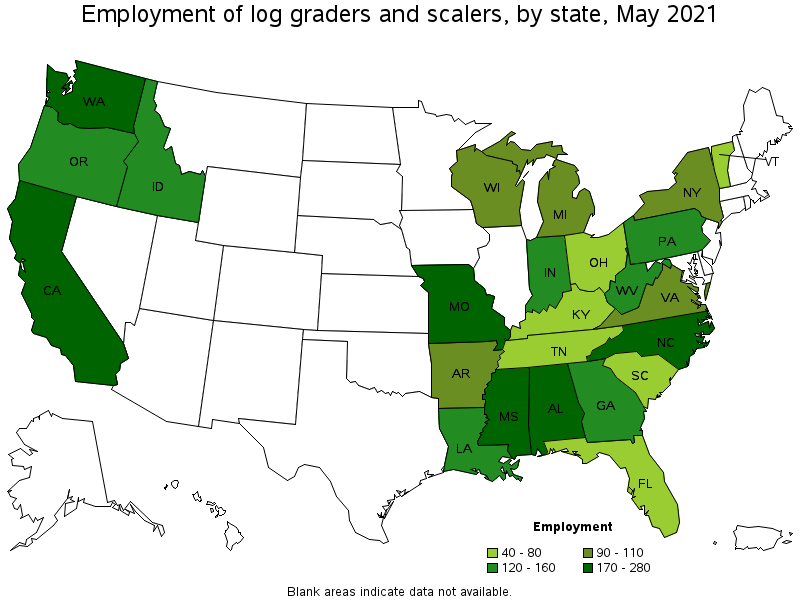
States with the highest employment level in Log Graders and Scalers:
| State | Employment (1) | Employment per thousand jobs | Location quotient (9) | Hourly mean wage | Annual mean wage (2) |
|---|---|---|---|---|---|
| North Carolina | 280 | 0.06 | 2.71 | $ 17.29 | $ 35,970 |
| California | 260 | 0.02 | 0.68 | $ 22.63 | $ 47,070 |
| Alabama | 220 | 0.11 | 4.85 | $ 18.72 | $ 38,940 |
| Washington | 200 | 0.06 | 2.67 | $ 23.83 | $ 49,560 |
| Missouri | 190 | 0.07 | 2.98 | $ 18.36 | $ 38,200 |
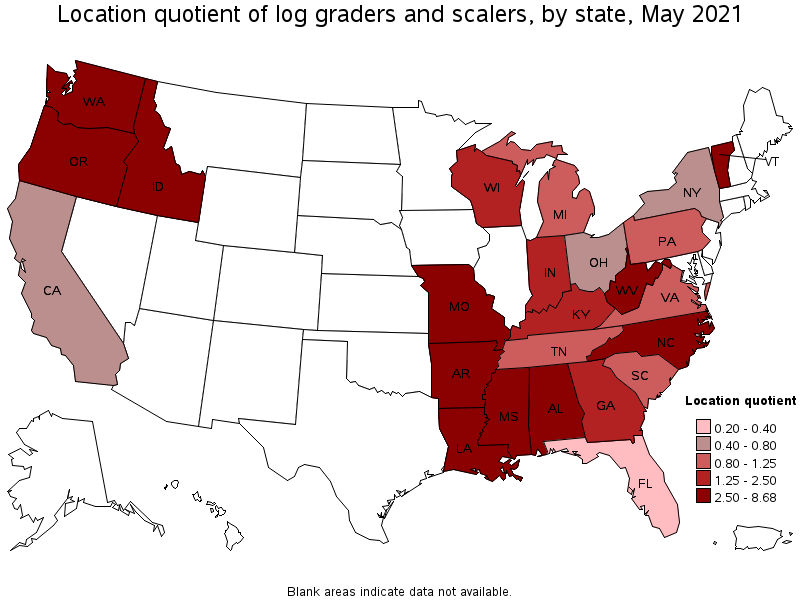
States with the highest concentration of jobs and location quotients in Log Graders and Scalers:
| State | Employment (1) | Employment per thousand jobs | Location quotient (9) | Hourly mean wage | Annual mean wage (2) |
|---|---|---|---|---|---|
| Idaho | 150 | 0.20 | 8.68 | $ 23.68 | $ 49,250 |
| West Virginia | 120 | 0.19 | 8.05 | $ 21.15 | $ 44,000 |
| Mississippi | 170 | 0.15 | 6.49 | $ 17.34 | $ 36,060 |
| Vermont | 40 | 0.14 | 6.11 | $ 18.16 | $ 37,770 |
| Alabama | 220 | 0.11 | 4.85 | $ 18.72 | $ 38,940 |
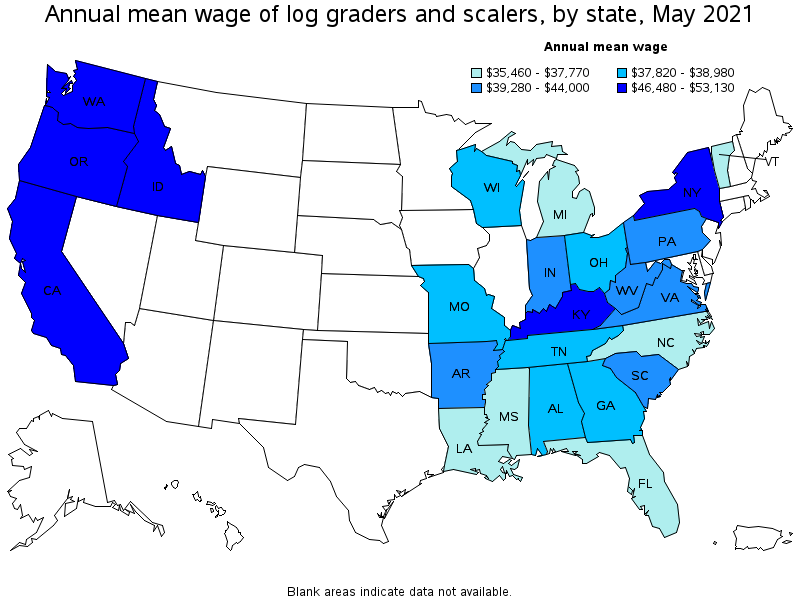
Top paying states for Log Graders and Scalers:
| State | Employment (1) | Employment per thousand jobs | Location quotient (9) | Hourly mean wage | Annual mean wage (2) |
|---|---|---|---|---|---|
| Oregon | 120 | 0.07 | 2.94 | $ 25.54 | $ 53,130 |
| Washington | 200 | 0.06 | 2.67 | $ 23.83 | $ 49,560 |
| Idaho | 150 | 0.20 | 8.68 | $ 23.68 | $ 49,250 |
| Kentucky | 70 | 0.04 | 1.55 | $ 22.66 | $ 47,140 |
| California | 260 | 0.02 | 0.68 | $ 22.63 | $ 47,070 |
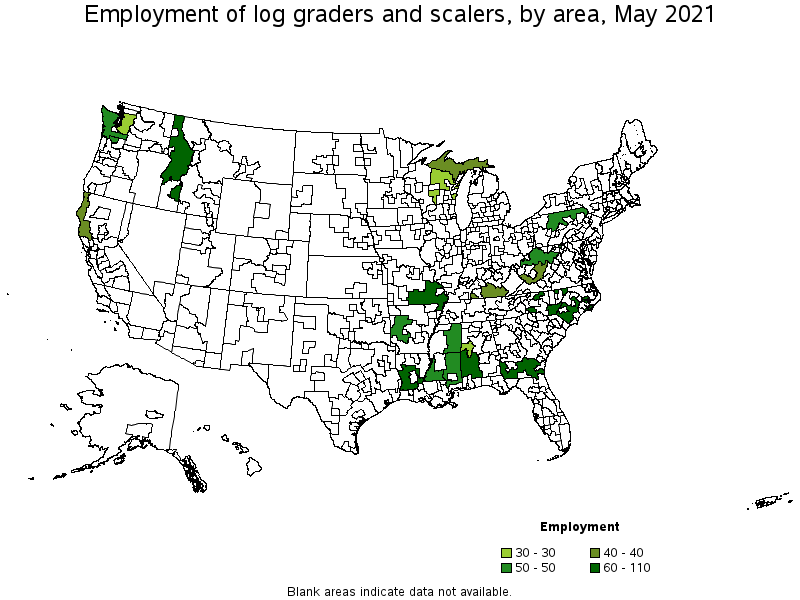
Metropolitan areas with the highest employment level in Log Graders and Scalers:
| Metropolitan area | Employment (1) | Employment per thousand jobs | Location quotient (9) | Hourly mean wage | Annual mean wage (2) |
|---|---|---|---|---|---|
| Longview, WA | 50 | 1.30 | 56.19 | $ 22.44 | $ 46,670 |
| Tuscaloosa, AL | 30 | 0.35 | 15.15 | $ 20.65 | $ 42,950 |
| Seattle-Tacoma-Bellevue, WA | 30 | 0.02 | 0.73 | $ 24.04 | $ 50,010 |
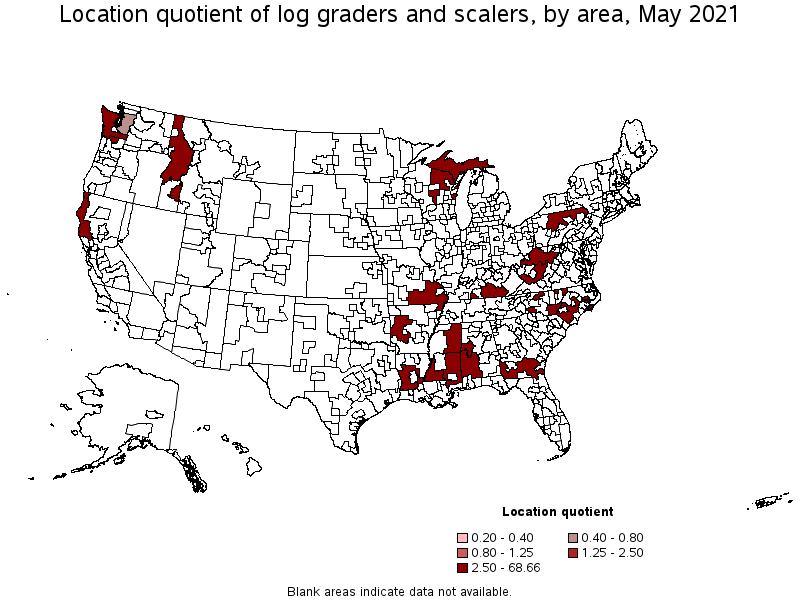
Metropolitan areas with the highest concentration of jobs and location quotients in Log Graders and Scalers:
| Metropolitan area | Employment (1) | Employment per thousand jobs | Location quotient (9) | Hourly mean wage | Annual mean wage (2) |
|---|---|---|---|---|---|
| Longview, WA | 50 | 1.30 | 56.19 | $ 22.44 | $ 46,670 |
| Tuscaloosa, AL | 30 | 0.35 | 15.15 | $ 20.65 | $ 42,950 |
| Seattle-Tacoma-Bellevue, WA | 30 | 0.02 | 0.73 | $ 24.04 | $ 50,010 |
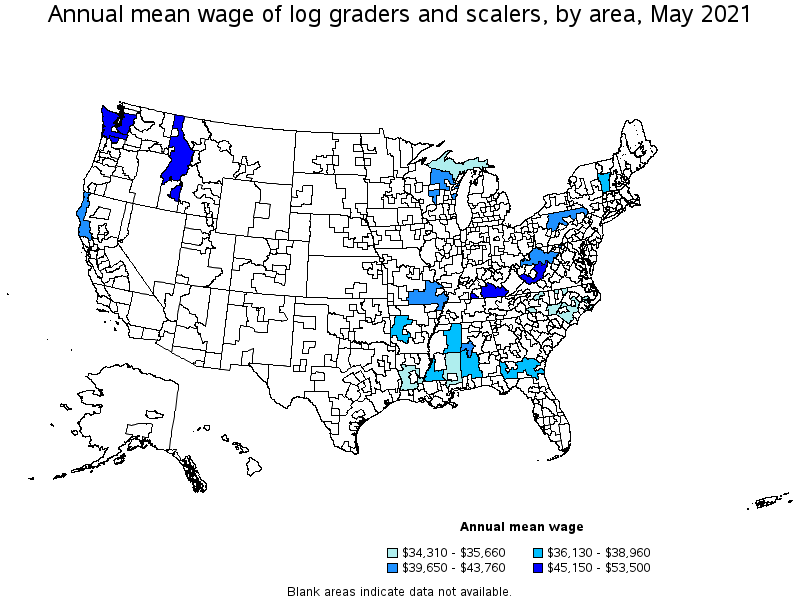
Top paying metropolitan areas for Log Graders and Scalers:
| Metropolitan area | Employment (1) | Employment per thousand jobs | Location quotient (9) | Hourly mean wage | Annual mean wage (2) |
|---|---|---|---|---|---|
| Seattle-Tacoma-Bellevue, WA | 30 | 0.02 | 0.73 | $ 24.04 | $ 50,010 |
| Longview, WA | 50 | 1.30 | 56.19 | $ 22.44 | $ 46,670 |
| Tuscaloosa, AL | 30 | 0.35 | 15.15 | $ 20.65 | $ 42,950 |
Nonmetropolitan areas with the highest employment in Log Graders and Scalers:
| Nonmetropolitan area | Employment (1) | Employment per thousand jobs | Location quotient (9) | Hourly mean wage | Annual mean wage (2) |
|---|---|---|---|---|---|
| Northwestern Idaho nonmetropolitan area | 110 | 1.59 | 68.66 | $ 23.29 | $ 48,440 |
| Southeast Missouri nonmetropolitan area | 100 | 0.61 | 26.26 | $ 19.06 | $ 39,650 |
| Southeast Coastal North Carolina nonmetropolitan area | 80 | 0.32 | 13.63 | $ 17.04 | $ 35,440 |
| Piedmont North Carolina nonmetropolitan area | 70 | 0.29 | 12.42 | $ 17.07 | $ 35,510 |
| Southwest Alabama nonmetropolitan area | 70 | 1.07 | 46.30 | $ 18.73 | $ 38,960 |
Nonmetropolitan areas with the highest concentration of jobs and location quotients in Log Graders and Scalers:
| Nonmetropolitan area | Employment (1) | Employment per thousand jobs | Location quotient (9) | Hourly mean wage | Annual mean wage (2) |
|---|---|---|---|---|---|
| Northwestern Idaho nonmetropolitan area | 110 | 1.59 | 68.66 | $ 23.29 | $ 48,440 |
| Southwest Alabama nonmetropolitan area | 70 | 1.07 | 46.30 | $ 18.73 | $ 38,960 |
| Central Louisiana nonmetropolitan area | 60 | 0.77 | 33.19 | $ 17.13 | $ 35,620 |
| Southwest Mississippi nonmetropolitan area | 50 | 0.70 | 30.25 | $ 17.88 | $ 37,190 |
| Southeast Missouri nonmetropolitan area | 100 | 0.61 | 26.26 | $ 19.06 | $ 39,650 |
Top paying nonmetropolitan areas for Log Graders and Scalers:
| Nonmetropolitan area | Employment (1) | Employment per thousand jobs | Location quotient (9) | Hourly mean wage | Annual mean wage (2) |
|---|---|---|---|---|---|
| Western Washington nonmetropolitan area | 50 | 0.45 | 19.39 | $ 25.72 | $ 53,500 |
| Northwestern Idaho nonmetropolitan area | 110 | 1.59 | 68.66 | $ 23.29 | $ 48,440 |
| South Central Kentucky nonmetropolitan area | 40 | 0.22 | 9.56 | $ 22.34 | $ 46,470 |
| Southern West Virginia nonmetropolitan area | 40 | 0.57 | 24.73 | $ 21.71 | $ 45,150 |
| Northern West Virginia nonmetropolitan area | 50 | 0.37 | 16.07 | $ 21.04 | $ 43,760 |
These estimates are calculated with data collected from employers in all industry sectors, all metropolitan and nonmetropolitan areas, and all states and the District of Columbia. The top employment and wage figures are provided above. The complete list is available in the downloadable XLS files.
The percentile wage estimate is the value of a wage below which a certain percent of workers fall. The median wage is the 50th percentile wage estimate—50 percent of workers earn less than the median and 50 percent of workers earn more than the median. More about percentile wages.
(1) Estimates for detailed occupations do not sum to the totals because the totals include occupations not shown separately. Estimates do not include self-employed workers.
(2) Annual wages have been calculated by multiplying the hourly mean wage by a "year-round, full-time" hours figure of 2,080 hours; for those occupations where there is not an hourly wage published, the annual wage has been directly calculated from the reported survey data.
(3) The relative standard error (RSE) is a measure of the reliability of a survey statistic. The smaller the relative standard error, the more precise the estimate.
(9) The location quotient is the ratio of the area concentration of occupational employment to the national average concentration. A location quotient greater than one indicates the occupation has a higher share of employment than average, and a location quotient less than one indicates the occupation is less prevalent in the area than average.
Other OEWS estimates and related information:
May 2021 National Occupational Employment and Wage Estimates
May 2021 State Occupational Employment and Wage Estimates
May 2021 Metropolitan and Nonmetropolitan Area Occupational Employment and Wage Estimates
May 2021 National Industry-Specific Occupational Employment and Wage Estimates
Last Modified Date: March 31, 2022